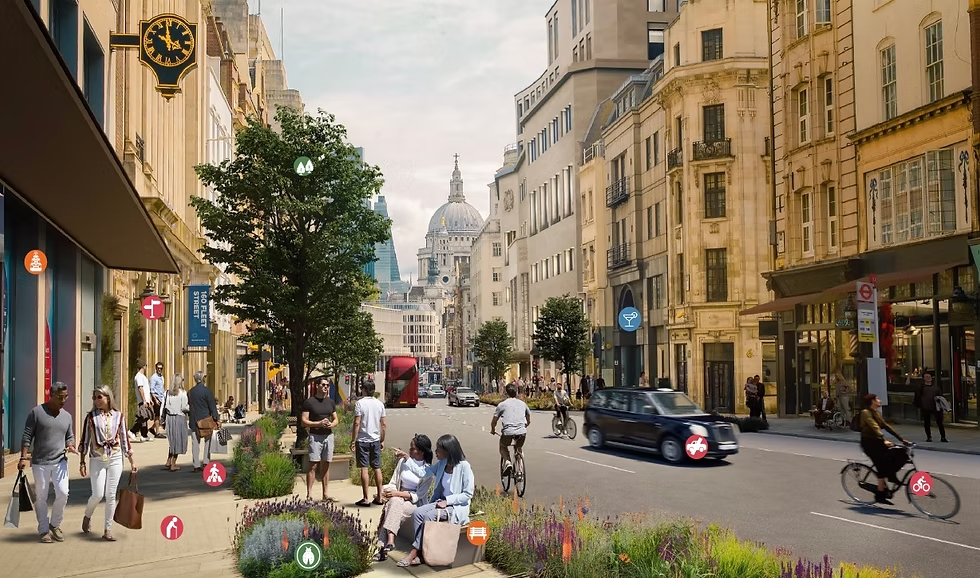

debating the future of the City



So the City Corporation sponsored the establishment of a fourth BID in the City, the Fleet Street Quarter Business Improvement District, which opened for business in 2022.
Two years on, Mike Fairmaner, former Westminster planner, now head of placemaking for the BID, Introduced an update for CAF members (ironically in the relocated, but possibly mislocated, Temple Bar) made it clear any diminution in vibrancy has not dimmed enthusiasm for major new development.
There are 29 schemes, he said, due to deliver an extra 610,000 sqm of floorspace (6.5m sq ft). The bulk of which are offices but including judicial, retail, hotel, student housing and cultural uses. That means at least another 24,000 workers to add to the existing 92,000. 24% of these are in legal and accounting occupations.
There is a clear priority to improve the public realm to entice visitors to dwell, to make it more coherent across five component neighbourhoods, welcoming and greener, and to maximise opportunities for new and upgraded public spaces, which are limited and not ‘green’. Gensler’s public realm strategy will provide a co-ordinated framework to meet the development pipeline, which includes the Salisbury Square Courts Complex on the south side of Fleet Street, where there will be new public space. The lack of seating and greening across the area is noticeable, nor is it ‘child friendly’ and limits the appeal for visiting families and tourists – and the idea of Fleet Street as a destination, other than for workers, despite its historical richness.

That idea of ‘destination’, the animating spirit of the City Plan 2040, is about ‘earning the commute’ in a post-Covid, WFH world, and restoring life to the City’s streets. The ‘new era of change’ Fairmaner described is about place enhancement for all.
Another spur is Farringdon station and the opening of the Queen Elizabeth Line. It has shifted London’s epicentre east. Farringdon’s north-south, east-west rail connections have swelled numbers walking south from the station into the Fleet Street area. Ludgate Viaduct and Ludgate Circus are therefore key longer term projects in the public realm strategy. On the short term list is the lighting of Holborn Viaduct and Fleet Street itself along with its courts (Gough Square) and alleys. These need of better lighting and enlivening to make them safer, more attractive to visitors and workers.
Curiously, the City’s Policy and Resources Committee debated the corporation’s relationship with its four BIDs in the same week preceding the update for CAF members. That debate raised questions around accountability, value, coherence, delivery and quality and who is responsible for what across the BID areas. It was interesting therefore to hear from Melanie Charalambous, Portfolio Manager for the City’s Environment Department prioritising turning ‘Strategy to Delivery’. There was a need to co-ordinate with the City BIDs and their respective business plans. Establishing goals for projects and a clear process, a ‘mechanism for delivery’, coordinated with all political levels, BIDs and other stakeholders, was essential to getting projects delivered. But often in the past the need for this essential component of delivery had been under developed. While the Fleet Street BID is talking about the public realm strategy, the Corporation has to deliver. Her first slide was titled ‘A Long Process’. There are many delicate and substantial stages to be negotiated between ‘strategy’ and ‘build’, she said. And the smallest of schemes can generate a large, and loud, local response which can substantially delay even these.

Screenshot

Screenshot
Within the Environment Department’s programme summary for the area, the transformation of Fleet Street is a ‘priority project’, and in the ‘short term’ there are proposals for small projects greening elements of Ludgate Broadway and St Andrews Hill, south of Ludgate, the Fleet Street courts and alleys, the lighting of Holborn Viaduct, Breams Buildings and a Ludgate Hill crossing. Medium term projects include improvements to Temple Avenue, Chancery Land and Tudor Street, while two long term projects are the transformation of Holborn and Ludgate Circuses.
Why these should be longer term was not completely clear. But why not now, given all the change anticipated?
She showed delicate, intriguing designs by Studio Weave for the courts and alleys off Fleet Street, to improve signage, lighting, thresholds to place, introducing greenery – ‘things that will encourage people to dwell,’ she said. The same can be said of the two new ‘parklet’ proposals for Ludgate Broadway and St Andrew’s Hill south of Ludgate Hill.
As for Fleet Street, designs were ‘emerging’ and £10m was allocated for this project in the summer thanks to the flexibility of allocating CiL monies, which she contrasted with the geographically limited funds available from S106 deals.
The idea of removing the bus lane and widening the pavements, possibly to 3m in places, is being modelled and tested before designs, to include new trees and greenery, are finalised.

Summing up, Gensler’s Ian Mulcahey said Fleet Street had ‘got to have a new purpose and a new role’. ‘Fleet Street,’ he said, ‘can be more than task-based. A destination with good pubs and great transport. The opportunity is immense. We’ve forgotten the spaces that were defined by dramatic gateways, such as Temple Bar, and the ceremonial entrance to the St Paul’s enclosure.’
There was however not much sign of symbolic gestures making a comeback in images shown. They would surely be popular.
Everything that made such a ceremonial route had been removed by traffic, he said. And in a post-Covid world where people can work from home: ‘How do you get people back into the office? You have to make a fantastic place. It can still be a task-based place, but why can’t people participate in that place, explore and relax in it and enjoy it rather than just passing through. It is the sad neglect of recent years that has created the opportunity,’ he concluded.
What is probably the best view of the City core’s cluster, CAF members agreed on their recent tour, is now available from the northern roof terrace of TBC.London – an environmentally and socially impactful remodelling of an unlovely 1980s building at 224-226 Tower Bridge Road, south-east of Tower Bridge that...
As in previous years as we come to the end of the year I wanted to write to you, our members, with a few reflections and a look ahead. So for 2020 – the year of the acronym… First, we had COVID and all the attendant horror of the pandemic,...
Citicape House, a hospitality-led, mixed-use project, is characterised by the largest green wall in Europe, creating a distinctive architectural addition to a gateway City of London site, while absorbing eight tonnes of pollution annually and setting the standard for urban greening in London. Dan Burr (Sheppard Robson) takes us through...